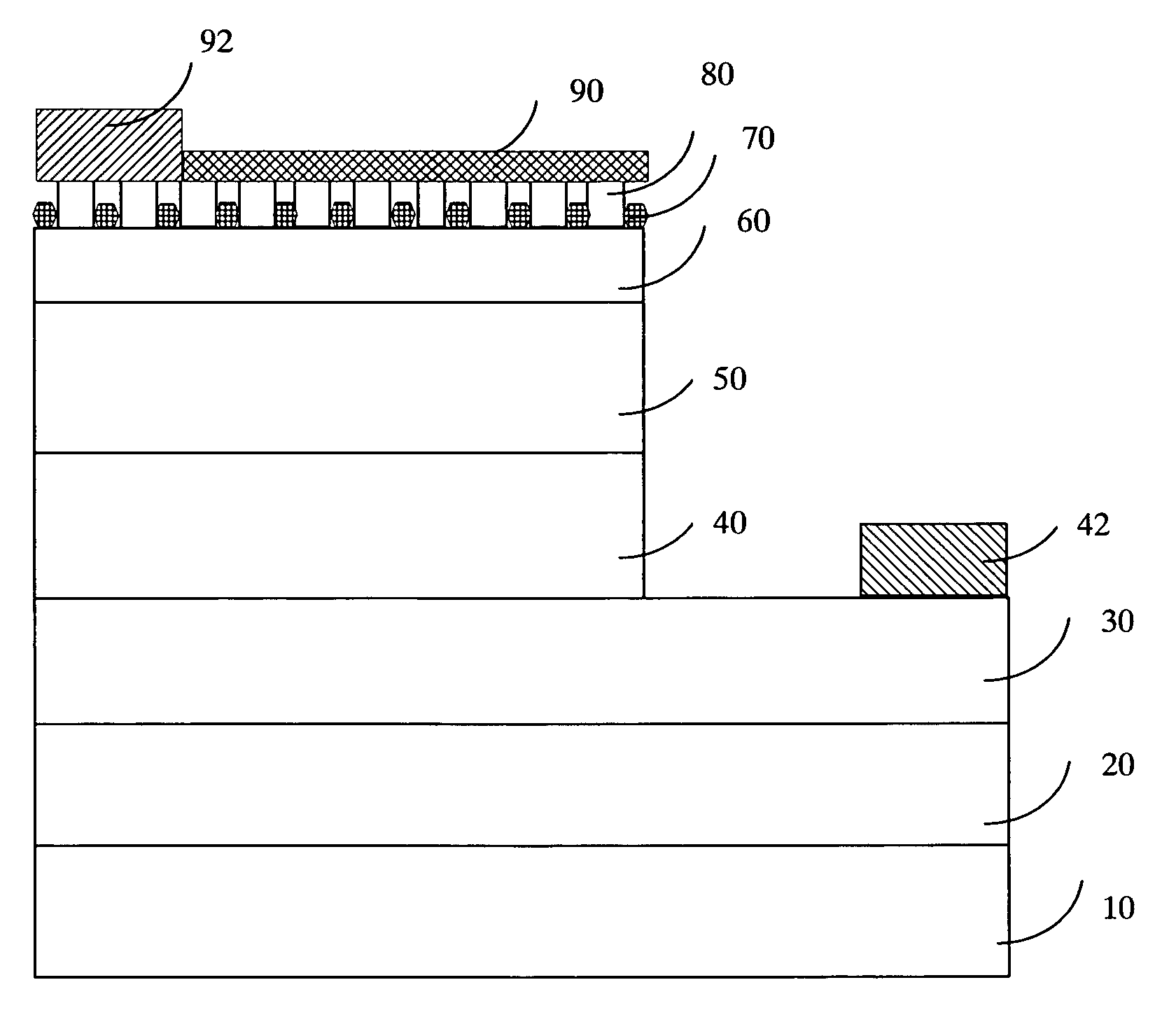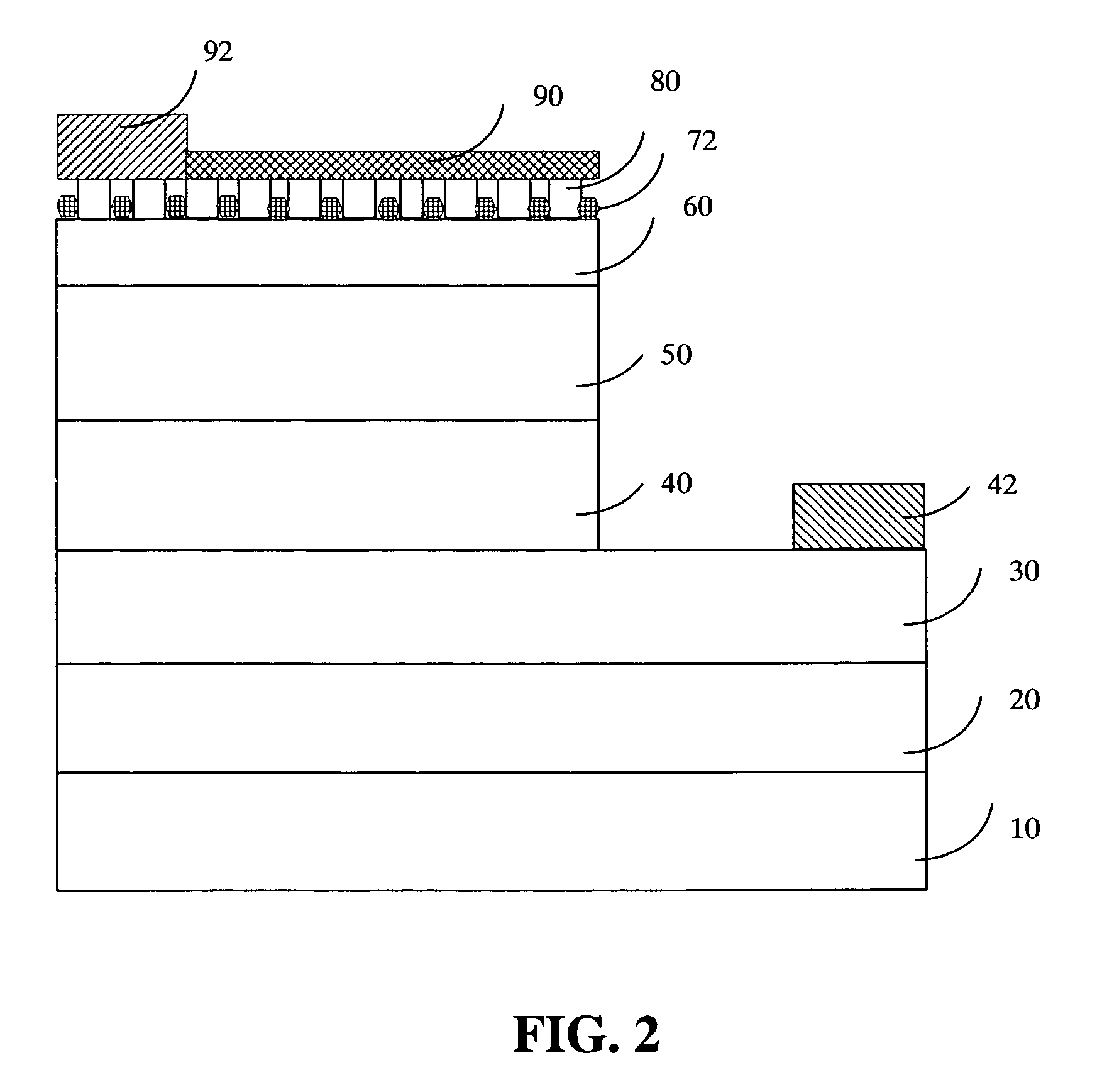High-brightness gallium-nitride based light emitting diode structure
a light-emitting diode, high-bright technology, applied in the direction of basic electric elements, electrical equipment, semiconductor devices, etc., can solve the problem of reducing the external quantum efficiency
- Summary
- Abstract
- Description
- Claims
- Application Information
AI Technical Summary
Benefits of technology
Problems solved by technology
Method used
Image
Examples
first embodiment
[0016]FIG. 1 is a schematic diagram showing the epitaxial structure of the GaN-based LEDs according to the present invention. As shown in FIG. 1, the GaN-based LED has a substrate 10 made of C-plane, R-plane, or A-plane aluminum-oxide monocrystalline (sapphire), or an oxide monocrystalline having a lattice constant compatible with that of nitride semiconductors. The substrate 10 can also be made of SiC (6H—SiC or 4H—SiC), Si, ZnO, GaAs, or MgAl2O4. Generally, the most common material used for the substrate 10 is sapphire or SiC. A buffer layer 20 made of AlaGabIn1-a-bN (0≦a,b10. Then, an n-type contact layer 30 made of a GaN-based material is formed on the buffer layer 20. On top of the n-type contact layer 30, there are an active layer 40 made of indium-gallium-nitride (InGaN) and a negative electrode 42, not overlapping with each other.
[0017]The present embodiment then forms a p-type cladding layer 50 made of a p-type GaN-based material on top of the active layer 40. In turn, on t...
second embodiment
[0020]FIG. 2 is a schematic diagram showing the epitaxial structure of the GaN-based LEDs according to the present invention. As shown in FIG. 2, the present embodiment has an identical structure as in the previous embodiment. The only difference lies in the material used for the masking buffer layer. Within the present embodiment, the masking buffer layer 72 is developed also by MOCVD using MggNh (g,h≧1) having a specific composition up to a thickness between 5 Å and 100 Å under a growing temperature between 600° C. and 1100° C. The masking buffer layer 72 is also a mask containing multiple randomly distributed MggNh clusters.
[0021]The present embodiment then develops a p-type roughened contact layer 80 made of AliInjGa1-i-jN, (0≦i,j80 does not grow directly on top of the masking buffer layer 72. Instead, the p-type roughened contact layer 80 starts from the top surface of the underlying p-type contact layer 60 not covered by the masking buffer layer 72's MggNh clusters. The p-type...
third embodiment
[0022]FIG. 3 is a schematic diagram showing the epitaxial structure of the GaN-based LEDs according to the present invention. As shown in FIG. 3, the present embodiment has an identical structure as in the previous embodiment. The only difference lies in the material used for the masking buffer layer. Within the present embodiment, the masking buffer layer 74 is developed also by MOCVD using heavily doped (>1×1020 cm−3) AlkIn1Ga1-k-1N (0≦k,172 is also a mask containing multiple randomly distributed AlkIn1Ga1-k-1N clusters.
[0023]The present embodiment then develops a p-type roughened contact layer 80 made of AlmInnGa1-m-nN, (0≦m,n80 does not grow directly on top of the masking buffer layer 74. Instead, the p-type roughened contact layer 80 starts from the top surface of the underlying p-type contact layer 60 not covered by the masking buffer layer 74's AlkIn1Ga1-k-1N clusters. The p-type roughened contact layer 80 then grows upward until it passes (but does not cover) the mask of the...
PUM
 Login to View More
Login to View More Abstract
Description
Claims
Application Information
 Login to View More
Login to View More - R&D
- Intellectual Property
- Life Sciences
- Materials
- Tech Scout
- Unparalleled Data Quality
- Higher Quality Content
- 60% Fewer Hallucinations
Browse by: Latest US Patents, China's latest patents, Technical Efficacy Thesaurus, Application Domain, Technology Topic, Popular Technical Reports.
© 2025 PatSnap. All rights reserved.Legal|Privacy policy|Modern Slavery Act Transparency Statement|Sitemap|About US| Contact US: help@patsnap.com



